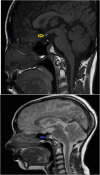Two Cases of Late Diagnosis Pituitary Stalk Interruption Syndrome and Literature Review
- PMID: 40129560
- PMCID: PMC11932035
- DOI: 10.2147/IMCRJ.S507989
Two Cases of Late Diagnosis Pituitary Stalk Interruption Syndrome and Literature Review
Abstract
Background: Pituitary stalk interruption syndrome (PSIS) is a rare congenital condition that includes the triad of a thin pituitary stalk, an ectopic posterior pituitary gland, and an absent or hypoplastic anterior pituitary gland and is usually diagnosed in infancy. This report presents two cases of late diagnosis of PSIS and a literature review of the relevant cases. The objective is to update data on such an uncommon syndrome to avoid the consequences of pituitary dysfunction including short stature, impaired cognitive function, negative impact on bone health, adrenal crises and delayed puberty.
Case report: In this paper, we report on two cases of late diagnosis of PSIS with a history of growth hormone deficiency. The first case is a 21-year-old female presenting with generalized fatigability, dizziness and delayed puberty, while the second case is a 19-year-old female presenting with secondary amenorrhea. The hormonal profile of the first patient revealed panhypopituitarism; the second case had growth hormone deficiency subsequently had secondary hypogonadism with intact thyroid and adrenal functions. The diagnosis of PSIS was confirmed by magnetic resonance imaging (MRI), and both cases were treated with hormone supplements. Progress was also tracked through planned follow-up sessions. To the best of our knowledge, this is the first case series of such late diagnosis PSIS from Saudi Arabia.
Conclusion: The key message of this paper is that rare etiologies such as PSIS should be kept in mind, especially for young patients presenting with clinical evidence of pituitary hormonal deficiencies, and MRI should be considered to confirm diagnosis. The early diagnosis, hormonal replacement, and long-term follow-up are crucial to reducing negative impacts of pituitary hormonal deficiencies.
Keywords: PSIS; combined pituitary hormone deficiency; growth hormone deficiency; pituitary stalk interruption syndrome.
© 2025 Alkhalifa et al.
Conflict of interest statement
The authors report no other conflicts of interest in this work.
Figures



Similar articles
-
Two cases of pituitary stalk interruption syndrome: importance of early detection and management.Ann Med Surg (Lond). 2024 May 6;86(6):3776-3780. doi: 10.1097/MS9.0000000000002123. eCollection 2024 Jun. Ann Med Surg (Lond). 2024. PMID: 38846834 Free PMC article.
-
Pituitary Stalk Interruption Syndrome: A Case and Literature Review.AACE Clin Case Rep. 2024 Oct 4;11(1):29-31. doi: 10.1016/j.aace.2024.09.007. eCollection 2025 Jan-Feb. AACE Clin Case Rep. 2024. PMID: 39896953 Free PMC article.
-
Pituitary stalk interruption syndrome: A rare case report and literature review.Medicine (Baltimore). 2020 Dec 11;99(50):e23266. doi: 10.1097/MD.0000000000023266. Medicine (Baltimore). 2020. PMID: 33327247 Free PMC article. Review.
-
Pituitary stalk interruption syndrome: A case report.Radiol Case Rep. 2023 Oct 3;18(12):4363-4365. doi: 10.1016/j.radcr.2023.09.010. eCollection 2023 Dec. Radiol Case Rep. 2023. PMID: 37840890 Free PMC article.
-
Post-traumatic pituitary stalk transection syndrome (PSTS) expeditiously manifested after a fall from a height combined with acute traumatic spinal cord injury: a rare case report with review of literature.Endocr J. 2024 Aug 8;71(8):817-824. doi: 10.1507/endocrj.EJ24-0091. Epub 2024 May 29. Endocr J. 2024. PMID: 38811206 Review.
References
Publication types
LinkOut - more resources
Full Text Sources

